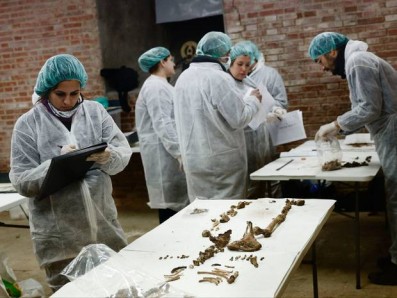
Scientists will use DNA to determine which of the bones belong to Cervantes, and which do not.
The last burial place of Miguel de Cervantes – author of arguably Spain’s most famous novel, Don Quixote – has been discovered in Madrid, nearly 400 years after the writer’s death.
The scientists working on the excavation believe that the tomb buried beneath the city’s Convent of the Barefoot Trinitarians contains the remains of Cervantes, his wife, and other, as-yet-unknown individuals…
Buried in 1616, the exact location of Cervantes’ coffin was lost a few years later when the convent – in whose grounds the writer wished to be buried – was demolished and rebuilt in the 17th Century.
At the time, the convent’s priests moved the remains and placed them in the new building, but the crypt has since lain forgotten and neglected beneath the dark and dank foundations of the gothic convent.
That was until a team of 30 researchers used state-of-the-art infrared cameras, ground-penetrating radar and 3D modelling to build up a picture of the convent’s foundations. Using modern technology, the researchers were able to pinpoint the tomb’s location in one of the 33 niches dotted along the far wall.
“The remains are in a bad state of conservation and do not allow us to do an individual identification of Miguel de Cervantes,” said Almudena Garcia Rubio, a forensic scientist working on the excavation. “But we are sure what the historical sources say is the burial of Cervantes and the other people buried with him is what we have found.”
Whether the bones can be fully verified as belonging to Cervantes or not, the entire find will be given a reburial complete with full honours at the convent, in keeping with the writer’s wish to be buried there.
The crypt in which Cervantes’s body lay undiscovered for so many centuries will be opened to the public next year in an occasion to mark the 400th anniversary of his death.
Cervantes was born in 1547 near Madrid, and after being injured fighting at the Battle of Lepanto in 1571 was captured and enslaved in Algiers, now modern-day Algeria, for five years. In 1605, as a newly free man, Cervantes published part one of The Ingenious Gentleman Don Quixote of La Mancha, with part two following a decade later.
The Don Quixote character is one of the most famous in the entire literary world, and has even spawned the term ‘Quixotic’ , which means “to be extremely idealistic, unrealistic and impractical”.
The forensic team working on the dig hope that this find sparks renewed interest in the book, which is already one of the world’s most widely read and translated works.
 en
en



 Vlaams-Nederlands
Vlaams-Nederlands
0 Comments
Leave a Comment
DISCLAIMER
The opinions and comments expressed by contributors to this Blog are theirs alone and do not necessarily reflect the views of VIVA Homes Under the Sun Ltd, any of its associated companies, or employees; nor is VIVA to be held responsible or accountable for the accuracy of any of the information supplied.
Have you got something to say?